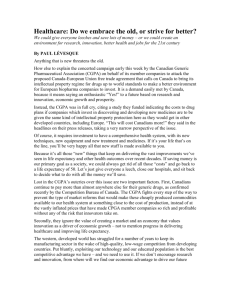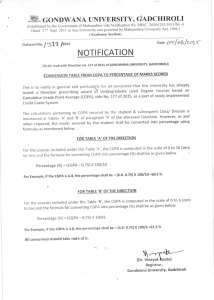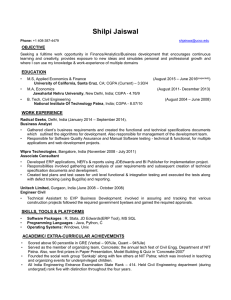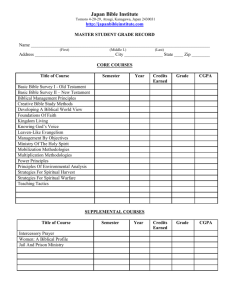Proceedings of 9th Annual London Business Research Conference
advertisement
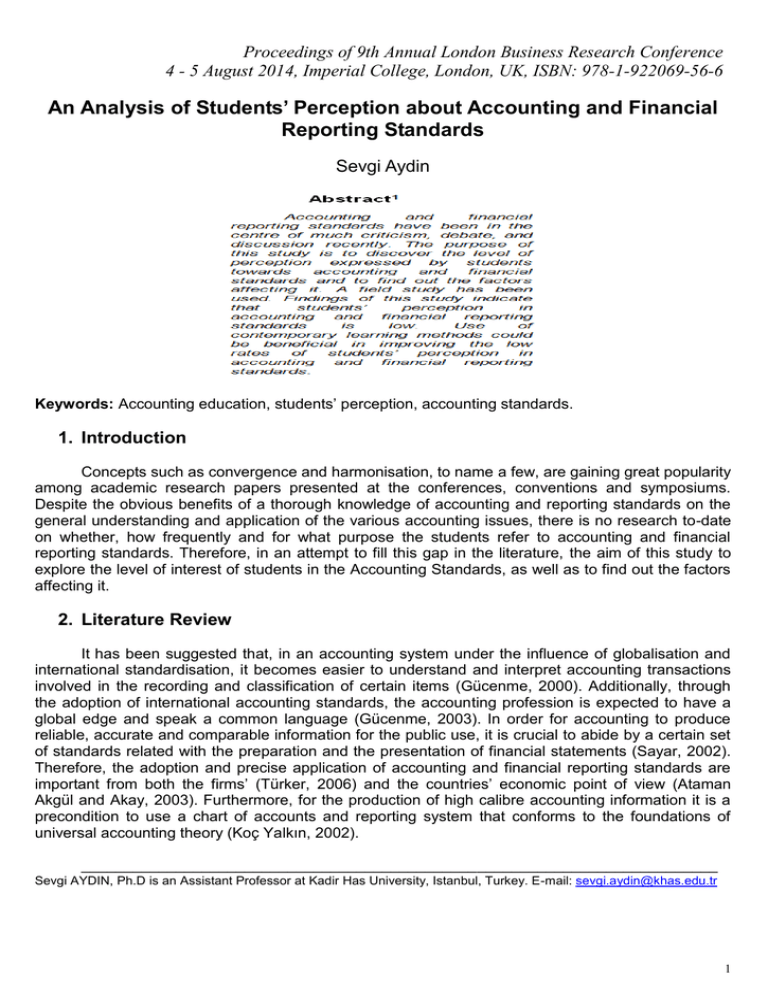
Proceedings of 9th Annual London Business Research Conference 4 - 5 August 2014, Imperial College, London, UK, ISBN: 978-1-922069-56-6 An Analysis of Students’ Perception about Accounting and Financial Reporting Standards Sevgi Aydin Keywords: Accounting education, students‟ perception, accounting standards. 1. Introduction Concepts such as convergence and harmonisation, to name a few, are gaining great popularity among academic research papers presented at the conferences, conventions and symposiums. Despite the obvious benefits of a thorough knowledge of accounting and reporting standards on the general understanding and application of the various accounting issues, there is no research to-date on whether, how frequently and for what purpose the students refer to accounting and financial reporting standards. Therefore, in an attempt to fill this gap in the literature, the aim of this study to explore the level of interest of students in the Accounting Standards, as well as to find out the factors affecting it. 2. Literature Review It has been suggested that, in an accounting system under the influence of globalisation and international standardisation, it becomes easier to understand and interpret accounting transactions involved in the recording and classification of certain items (Gücenme, 2000). Additionally, through the adoption of international accounting standards, the accounting profession is expected to have a global edge and speak a common language (Gücenme, 2003). In order for accounting to produce reliable, accurate and comparable information for the public use, it is crucial to abide by a certain set of standards related with the preparation and the presentation of financial statements (Sayar, 2002). Therefore, the adoption and precise application of accounting and financial reporting standards are important from both the firms‟ (Türker, 2006) and the countries‟ economic point of view (Ataman Akgül and Akay, 2003). Furthermore, for the production of high calibre accounting information it is a precondition to use a chart of accounts and reporting system that conforms to the foundations of universal accounting theory (Koç Yalkın, 2002). __________________________________________________________________________ Sevgi AYDIN, Ph.D is an Assistant Professor at Kadir Has University, Istanbul, Turkey. E-mail: sevgi.aydin@khas.edu.tr 1 Proceedings of 9th Annual London Business Research Conference 4 - 5 August 2014, Imperial College, London, UK, ISBN: 978-1-922069-56-6 It is generally assumed that higher education is meant to equip the person with the necessary knowledge, skills and tools which will be of great importance for career and personal advancement. With the rapid technological progression making it possible to acquire information in a low-cost, fast and easy way, the business world is currently undergoing a major transformation. Globalisation, online information flows and e-trade have not only put businesses under pressure to re-think and redesign their management tools, but also made an impact on the accounting profession and accounting education (Mohamed and Lashine, 2003). Therefore the accounting curriculum, especially in Business Schools and Faculties of Economics and Administrative Sciences, needs to incorporate contemporary and innovative teaching methods to catch up with the new rules of the game (Albrecht and Sack, 2000). Contemporary learning techniques are to help students attain better academic performance. As a one of the contemporary learning technique, cooperative learning, also promotes the team spirit in the classroom and leads students to not only concentrate on their own personal success but also on the success of the group (Slavin, 1990). Empirical studies in the literature provide evidence in support of the view that cooperative learning techniques have a positive impact on students‟ learning and performance (Paisey and Paisey, 2005). Professional accounting bodies have indeed been recommending the use of cooperative learning techniques for accounting education for many years (AECC, 1990; AICPA, 1988). Additionally, regular and direct feedback during the cooperative learning process is shown to be much more effective and to have a more positive impact on learning than irregular and indirect feedback (Rosenshire and Stevens, 1986; Kulik and Kulik, 1989). It is also a relatively low cost method and does not require any additional costs than those already required by conventional learning methods (Büyükkaragöz and Çivi, 1999). However, during the application of cooperative learning methods, is crucial to make sure that the students involved understand the value of working in groups, possess the necessary information for successful group-work, and make a conscious effort (Demirel, 2005). Despite all these obvious advantages, the adoption of cooperative learning techniques in accounting education is still not very wide spread. In Turkish Universities it is extremely rare to see special tutorials, outside the formal lecture hours, in which students can discuss certain issues in small groups, receive feedback on the course material covered and to simply interact with each other in a way to promote each others‟ understanding of the course. 3. Research Methodology 3.1. Research Design A field study has been used. Group-style questionnaires were applied which based on the survey used by Paisley and Paisley (2005), translated into Turkish and modified to reflect the accounting environment in Turkey, the questionnaire comprised questions on exposure to accounting and financial reporting standards, students‟ academic background and personal factors. Response rate is about 90%, which makes 212 fully completed questionnaires. 3.2 Study Sample The study sample consist of all undergraduate students who have passed General Accounting I and II courses at a Faculty of Economics and Administrative Sciences. Students were asked whether they have examined the Turkish and international accounting and financial reporting 2 Proceedings of 9th Annual London Business Research Conference 4 - 5 August 2014, Imperial College, London, UK, ISBN: 978-1-922069-56-6 standards, how frequently and for what purpose they have examined these standards, and how useful they thought the standards were in their understanding of the various topics during the accounting courses they took. Additionally collected information on their respective departments, academic year, sex, cumulative grade point average (CGPA), grades attained on the General Accounting I and II courses, whether they plan on working in the field of accounting in the future, and whether their parents are working in a field related with accounting. 3.3. Data Analysis First, univariate logistic regressions applied on each of the above variables included in the analysis with the dependent variable equal to 1 if the student has examined at least one standard and 0 otherwise. Using the statistically significant variables attained in this analysis, then construct a multivariate logistic regression model. As can be seen in Table 1, out of the 212 students in the analysis, 33% (70) is from business management, 22% (47) is from economics, and 45% (95) is from public finance departments. The categories used for the CGPA and accounting course grades are based on the new examination regulations, which uses the relative evaluation method (the normal curve), that went into effect on September 2006 in the University. 31 % of the students have a CGPA below 1.79, which is accepted as being on probation, meaning that the student is not allowed to take on new courses in the next semester. 31% of the students who took General Accounting I (GA-I) and 37% of the students who took General Accounting II (GA-II), attained a grade below 70 (CC in the letter grading system), which corresponds to a „conditional pass‟ in the new system (the condition is to keep the CGPA greater than 2.0). 51% of the respondents said they would consider a career in accounting in the future, and only 9% had parents working in an accounting related job. 3 Proceedings of 9th Annual London Business Research Conference 4 - 5 August 2014, Imperial College, London, UK, ISBN: 978-1-922069-56-6 Table 1. General Attributes of the Respondents Variables Department Academic Year Sex CGPA GA-I Grade GA-II Grade Busi. Man. Economics Public Fin. 2 3 4 Leap year Female Male 0-1.79 1.80-1.99 2.00-2.49 2.5 and over 50-69 70-74 75-79 80 and over 50-69 70-74 75-79 80 and over Yes Would consider a career in accounting No in the future Parents working in Yes an accounting No related job Frequency (%) 33 22 45 14 37 42 7 33 67 31 12 29 28 31 36 10 23 37 28 11 24 51 49 9 91 As depicted in Table 2, 88% of the students have examined the Turkish Accounting Standards (TAS), and 17% have examined the Turkish Financial Reporting Standards (TFRS). These percentages fall sharply when it brings in the international dimension. Only 11% have examined the International Accounting Standards (IAS) and 14% have examined the International Financial Reporting Standards (IFRS). In terms of frequency, 22% regarded their usage of TAS as „very limited‟ and 12 % as „moderate‟. However, for the remaining standards usage rate falls to 4% for IAS and to 3% for TFRS and IFRS. 4 Proceedings of 9th Annual London Business Research Conference 4 - 5 August 2014, Imperial College, London, UK, ISBN: 978-1-922069-56-6 Table 2. Accounting and Financial Reporting Standards -Usage Rates Have you examined the following standards? Yes No (%) (%) TAS TFRS IAS IFRS 88 17 11 14 12 83 89 86 How frequently have you examined the following standards? Never Very (%) limited (%) 12 22 83 12 89 7 86 10 Moderate (%) 12 3 4 3 Extensi ve (%) 4 1 0 1 Table 3. Contribution of Accounting and Financial Reporting Standards in Students‟ Comprehension of Topics Covered in the General Accounting Courses How would you rate the helpfulness of the standards to your understanding of the topics covered in GA-I and GA-II Very Moderate Extensive None limited (%) (%) (%) (%) TAS 54 18 20 7 TFRS 74 13 10 3 IAS 78 11 8 2 IFRS 78 13 8 1 Also 54% of the students TAS have not at all been helpful in their understanding of the topics covered in the general accounting courses, as can be seen in Table 3. The respective figures for the rest of the standards are, 74% for TFRS, and 78% for IAS and IFRS. Additionally, 18% of the students rated the helpfulness of TAS as „very limited‟, 20% rated its helpfulness as „moderate‟, while 7% rated it as „extensive‟. The corresponding fıgures for the other standards are much lower. Table 4. Purposes of usage of Accounting and Financial Reporting Standards Used the Standards for the following purposes Yes No (%) (%) Coursework Preparation Preparation for lectures Thesis Preparation Supplement Lecture Notes How much use did you make of the standards for the following purposes? Never Very (%) limited (%) 50 19 50 50 49 51 51 9 39 91 61 91 61 Moderate Extensive (%) (%) 22 9 26 15 8 4 20 3 9 2 10 As shown in Table 4, 50% of the students used the standards for coursework preparation, 49% for preparation for lectures, 9% for thesis (final dissertation) preparation and 39% for supplementing 5 Proceedings of 9th Annual London Business Research Conference 4 - 5 August 2014, Imperial College, London, UK, ISBN: 978-1-922069-56-6 lecture notes. For coursework preparation, 19% of the students regarded their use of the standards as „very limited‟, 22% as „moderate‟ and 9% as „extensive‟ use. The rates for thesis preparation are the lowest among the all the categories. Out of the 9% of students who have used the standards for thesis preparation, 4% made „very limited‟, 3% made „moderate‟ and 2% made „extensive‟ use of them. In Table 5 presented the Pearson correlation coefficients between the CGPA, the GA-I grade and the GA-II grade attained. Seen that these 3 measures are positively and statistically significantly (at the 1% level) correlated with one another. The highest correlation exists between the GA-I and GA-II grades, with a coefficient of 0.41. Table 5. Pearson Correlation Coefficients CGPA CGPA GA-I Grade GA-II Grade 0.28*** 0.35*** GA-I 0.41*** Grade (*** Significance (2-tailed) at the 0.01 level. Then univariate logistic regressions performed on each of the variables included in the analysis with the dependent variable equal to 1 if the student has examined at least one standard and 0 otherwise. In Table 6, presented the results of the multivariate logistic regression analysis using the significant variables attained in the univariate analysis. The aim is to find out, to what extent the students‟ perception towards the standards can be explained by the variables have included in the analysis. Out of the 8 independent variables have used, only being in the business management department and being female are statistically significantly (at the 5% and 1% levels, respectively) and positively related with perception in the standards, when compared to being in the other 2 departments in the faculty and being male. On the other hand, having a CGPA in the 2.00-2.49 band is statistically significantly (at the 1 % level) and negatively related with perception in the standards, when compared to having a CGPA higher than 2.49. The regression model itself is significant at the 1% level (P-value<0.001) and can explain 28% of the variation in the students‟ perception in the accounting and financial reporting standards. 6 Proceedings of 9th Annual London Business Research Conference 4 - 5 August 2014, Imperial College, London, UK, ISBN: 978-1-922069-56-6 Table 6. Logistic Regression Analysis Independent Variables Department Busi. Man. Economics Academic Year 2 3 4 Sex Female CGPA 0-1.79 1.80-1.99 2.00-2.49 Consider a career in accounting in the Yes future Parents working in an accounting Yes related job Constant Model Nagelkerke R2 Chi-square B Sig.(P) 0.980 0.747 -1.535 -1.347 -0.244 1.093 -0.721 -0.331 -1.178 0.017 0.104 0.084 0.058 0.723 0.002 0.103 0.529 0.005 0.454 0.205 1.022 0.083 0.120 0.883 0.284 50.782 0.000 4. Results The fact that 51% of the students said they would consider a career in accounting in the future, shows that the accounting education they receive in university is actually very important for their career advancement. Additionally, it also shows that the research question were asking is very relevant and that it is crucial to search for novel methods and review existing ones to continuously improve the system of accounting education. 31% of the students have a CGPA below 1.79, which is accepted as being on probation, meaning that the student is not allowed to take on new courses in the next semester. Furthermore, when the students‟ CGPA falls below 2.0, their „conditional pass‟ grades are converted to „fail‟. 43% of the students have surveyed are in this position. Although this may seem as poor performance in general, it can actually be considered quite normal, taking into account the fact that in the previous system in effect it was sufficient to attain a grade of 60 and over to pass a course. The CGPAs of students in their 3rd year and over were adversely affected by this change of system. Despite the fact that the students‟ perception in TAS was higher than the other standards, majority of those who had examined the standards rated their usage as „very limited‟. To make the picture look even gloomier, majority of the students thought that the standards were not helpful at all in their understanding of the various topics covered in the general accounting courses. There could be various explanations behind these findings. First and foremost, the accounting curriculum, with specific reference to the general accounting courses, may not be in a position to fully embrace and from links between the theory and the standards of accounting and financial reporting. It can be argued whether it is acceptable to talk about the practice side of many of the issues in accounting without touching upon the national and international standards in effect, at an introductory or moderate level accounting course. 7 Proceedings of 9th Annual London Business Research Conference 4 - 5 August 2014, Imperial College, London, UK, ISBN: 978-1-922069-56-6 Secondly, especially with respect to the international standards, lack of proficiency in English could be driving these results since the medium of education is Turkish. Although it is now compulsory for students to participate in the foreign language preparatory program, prior to the commencement of their studies in their respective departments, if they fail the test of their chosen language, students in their 3rd year and over were not affected by this prerequisite. Therefore, their command of a foreign language might be less proficient than the newer entrants. Lastly and most importantly, it might simply be an awareness issue, in the sense that, the students may not be aware of what is available to them and the potential benefits of putting the time and effort into accessing these standards. Furthermore, appallingly low rates of usage of the standards for the purposes of thesis preparation. This finding is quite surprising considering the fact that, in all 3 departments included in the study, it is compulsory for students to prepare a thesis (final dissertation) in their final year. Additionally, these results become even more surprising when taken into account the fact that 51% of the students said they would consider a career in accounting. Therefore it would expected that students to choose thesis topics which would help them in the advancement of their career in the future. Clearly this was not the case with respondents. One possible explanation could be that the students‟ area of perception was not in the domain of accounting. However, even though the thesis topic may not be directly related to accounting, it might somehow have a component that requires forming links with accounting concepts and referring to the standards. Another explanation could be that there are other factors in play when choosing a thesis topic, such as choosing a lecturer who is known to have a generous grading policy or a lecturer with stronger communication with and a generally more supportive attitude towards students, to name a few. It could also be due to the departmental policy as to which topics will be available for preparing a thesis in that particular academic year. Another interesting finding of this study was the positive and statistically significant correlation found between CGPA, the GA-I and the GA-II grades attained. The highest correlation between the GA-I and GA-II grades have found which does make sense because these two courses possess continuity. So, it‟s expected a student who has attained a high grade in one to also attain a high grade in the other. However, with the normal curve system in effect, it is possible for students to pass a course with a D+, on the condition that their CGPA is higher than 2.0. Therefore, a high grade in the accounting courses does not have to warrant a higher CGPA unless the student has a specific affinity towards accounting. In other words, a student who has a no interest what so ever in accounting for example, might have a conditional pass from accounting courses, but still get a high CGPA with high performance in other management courses. 5. Discussion and Conclusion The aim of the study was firstly to describe the students‟ perception towards accounting and financial reporting standards as well as their rates of access of these standards. Secondly, our aim was to uncover the explanatory factors behind students‟ perceptions. The scale and scope of perception was generally extremely low and, although preparation of coursework and preparation for lectures were cited as the most frequent source of perception, majority of the respondents felt that the standards were unhelpful in their understanding of the topics covered in the accounting courses they took. In terms of the factors driving these results, overall, the students‟ department, sex and CGPA has the greatest significant impact on the expressed perception in the standards. 8 Proceedings of 9th Annual London Business Research Conference 4 - 5 August 2014, Imperial College, London, UK, ISBN: 978-1-922069-56-6 The picture elsewhere in the world is not too far from ours, in the sense that, although the magnitude of the problem may differ across countries, universities and educational bodies around the world are looking into ways that will help build a bridge beten practice and research in accounting education (AACSB, 2004). Different types of action research with regard to cooperative learning are proposed in the literature as significant players in this process (Paisey and Paisey, 2005). It is clear that the adoption of cooperative learning methods could be beneficial in improving the low rates of student perception especially in IAS, TFRS, and IFRS. There is so much that needs to be explored and explained in this area and the results of this study will make a contribution and also provide the motivation for further research. References AACSB (2004) (The Association to Advance Collegiate Schools of Business), Eligibility procedures and standards for accounting education, AACSB International, St. Louis. (also available from: http://www.aacsb.edu) AECC (1990) (Accounting Education Change Commission), Objectives of Education for Accountants: Position Statement No.1, Issues in Accounting Education 5/2, 307-312. Albrecht, W.S & Sack, R.J. (2000) Accounting Education: Charting the Course through a Perilous Future, American Accounting Association, Accounting Education Series 16, USA. AICPA (1988) (American Institute of Certified Public Accountants), Educational Requirements for Entry into the Accounting Profession, 2nd edn., New York. Ataman Akgül, B. & Akay, H. (2003) Uluslararası Muhasebe Standartları ve Türkiye‟de Uygulama Etkinliğine İlişkin Bir Araştırma, Türkmen Kitabevi, İstanbul. Büyükkaragöz, S. & Çivi, C. (1999) Genel Öğretim Metotları – Öğretimde Planlama Uygulama 10. Baskı, Beta Basım Yayım Dağıtım, İstanbul. Çelik, O. & Gürdal, K. (1999) “Muhasebe Eğitiminde Kalite Arayışları ve Akreditasyon (Eşdeğerleme) Standartları", Muhasebe Bilim Dünyası Dergisi, 1(2). Demirel, Ö. (2005) Kuramdan Uygulamaya Eğitimde Program Geliştirme,8. Baskı, Pegem Yayıncılık, Ankara. Gücenme, Ü. (2000) “Küreselleşmede Muhasebe Standartları”, Muhasebe ve Finansman Dergisi, 5, 7-11. Gücenme, Ü. (2003) “Muhasebe Uygulamalarının Türkiye Muhasebe Standartlarına Uyumu”, Muhasebe ve Finansman Dergisi 19, 27-35. Koç Yalkın, Y.(2002) “Muhasebe Standartları ve Türkiye Uygulaması”, Muhasebe Bilim Dünyası Dergisi, 4(2). Kulik, J.A. & Kulik, C.C. (1989) Meta-Analysis in Education, Internetional Journal of Educational Research, 27. Mohamed, E.K.A. & Lashine, S.H.(2003) “Accounting Knowledge and Skills and the Challenges of a Global Business Environment”, Managerial Finance, 29(7). Orhaner, E. & Tunç, A (2001) Ticaret ve Turizm Eğitiminde Özel Öğretim Yöntemleri, Gazi Kitabevi, Ankara. Paisey, C.& Paisey, N.J. (2005) “Improving Accounting Education Through the Use of Action Research”, Journal of Accounting Education, 23. Rosenshine, B. & Stevens, R (1986) Teaching Functions, Handbook of Research in Teaching, New York, Macmillan. Saban, A. (2000) Öğrenme Öğretme Süreci – Yeni Teori ve Yaklaşımlar, Nobel Yayın Dağıtım, Ankara. 9 Proceedings of 9th Annual London Business Research Conference 4 - 5 August 2014, Imperial College, London, UK, ISBN: 978-1-922069-56-6 Sayar, A.R.Z. (2002) “Oluşturulmakta Olan Türkiye Muhasebe Standartları Kurulu‟nun Işığı Altında Türkiye‟de Muhasebe Standartlarının Mevcut Durumu ve Kamuyu Aydınlatma”, Muhasebe ve Denetime Bakış, 2(7). Slavin, R.E. & Englewood Cliffs; N.J (1990) Cooperative Learning Theory, Research and Practise, Prentice Hall. Türker, M.(2006) “Uluslararası Denetim Standartları‟na Yakınsama ve Türkiye Denetim Standartları‟nın Oluşturulması”, Muhasebe ve Denetime Bakış, 6(19). Türker, M. & Okay Örerler, E. (2004) Türk İşletmelerinin Küresel İşletme Haline Getirilme Yolları, İstanbul Ticaret Odası Yayın No: 2004-60, İstanbul. 10


